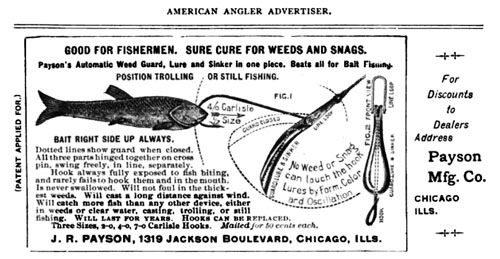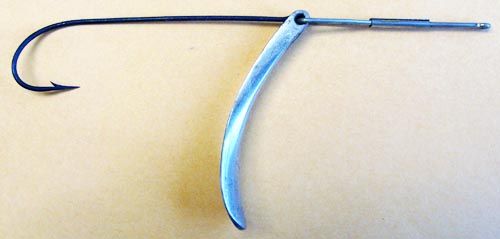Payson's Automatic Weed Guard, Hook & Sinker
30 years ago it was not unusual to find tackle boxes from the turn of the last century. They were usually small, made from tin and finished with black or green lacquer. There weren't that many people out there looking for them and much of the stuff in those boxes just wasn't that attractive to the average person. The more shiny, colorful baits of the 1920s were plentiful (due to good economic times during that decade) and they more often caught the eye of collectors.
Most Bass fishing before 1910 was done with live bait and there were all sorts of frog and minnow harnesses as well as weedless hooks that sometimes defied explanation as to how they were to be used. One of these was the “Payson Automatic Weed Guard, Hook & Sinker.” After I found a few of these well made pieces, I could not figure out how they were suppose to function. Luckily, the “Payson” was often advertised in magazines of the day with an illustration, otherwise I'd still be scratching my head. The ad presented here (top) for the “Payson” hook is from the 1895 William Mills & Son Catalog. The ad below is from the May 1893 American Angler magazine and likely is the introductory advertisement, as it is marked "Patent Applied For" and not "Patent Pending."


Even after seeing this ad and reading that it was suppose to be a weedless feature, I still could not picture how the thing was suppose to work as the weight of the weedless device was so heavy that the hook would ride through the water with that device on the underside and thus free to swing down away from the hook. This is another case where I should have read the ad more carefully and saved myself several years of head scratching. The heavy, well made weedless arm was suppose to act as both a weed guard when dragging the bait over an obstacle and as a sinker to aid in casting and getting the bait down. Judging from the size of the hooks, some very big bait was involved! Contained in the ad is the statement that the Payson "lures by form, color and ocillation." "Ocillation" sounded to me like a wiggling action. I decided to test this out and took a few casts with several Paysons off the dock in clear water. The hooks with the "shoe horn" shaped weedguard (as shown in the ad) wiggled in somewhat the same fashion as a Johnson Silver minnow if reeled at the right speed. The correct speed proved to have a fairly narrow range and the whole affair tended to spin if reeled a bit too fast. The hooks with the wider weedguard, with the oval shaped hole, did not wiggle but they also did not spin when reeled at high speed. Make of these results what you will, but remember the wooden “wigglers” and the “wobblers” were still 20 years off in the future when the “Payson” was patented in January of 1894.
There are at least a dozen or more sizes and variations to the “Payson.” The following pictures show a small sample of “Payson” hooks and how the hinged arm swings down. These are quite heavy for their size and (as the ad predicts) cast easily into a stiff wind.



One more thing--I wish when we found those early tackle boxes we had left them and their associated artifacts together as a unit. They were a view into the past that cannot be reconstructed. Alas -- those tackle boxes were broken up and the contents made their way into various collections. Much of the small incidental stuff did not seem that important at the time and has been lost. I recall one tackle box which did not have anything in it made after 1904 and that included a tin of chewing tobacco with a 1902 revenue stamp on it. How I wish I had left that box as it was found. Hind sight is a belated teacher.
-- Older and Wiser Bill
No comments:
Post a Comment